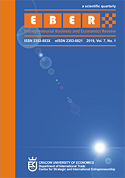Innovation strategies of manufacturing companies during expansions and slowdowns
Innovation strategies of manufacturing companies during expansions and slowdowns
Author(s): Jagoda Kaszowska-MojsaSubject(s): Economy, Business Economy / Management, Methodology and research technology
Published by: Uniwersytet Ekonomiczny w Krakowie
Keywords: innovation strategies; manufacturing sector; CIS survey; slowdown; procyclicality; countercyclicality;
Summary/Abstract: Objective: The aim of the article is to analyse the differentiation in the innovation strategies of the manufacturing companies during economic expansions and slowdowns. Research Design & Methods: The random-effect logistic regression models were used to examine the differentiation of a firm’s innovation strategies and the probability of innovating in different phases of the business cycle. I used the proprietary Innovation Survey (PNT-02) data, which overlap with the Community Innovation Survey (CIS). Findings: The analyses suggest that the likelihood of implementing innovation changes with the deterioration of macroeconomic conditions. There are groups of manufacturing firms in Poland whose innovation activities are procyclical and countercyclical. Implications & Recommendations: My analyses will help to understand the innovation strategies of the firms. This, in turn, should help to direct public support where it can be used more effectively. The recommendations will be relevant for the National Innovation System in Poland, as they should counterbalance the procyclical impact of a slowdown on a firm’s innovation spending and cooperation in innovation activities. Contribution & Value Added: Previously, the PNT-02 data for 2004-2006 and 2006- 2008 were used in the FP6 project on micro determinants of growth (MICRODYN) to identify the barriers to the innovation of the firms and the factors that decreased the probability of firms’ innovativeness. This study indicated a differentiation of the competences between firms that implemented innovation in two periods compared to those that only did so in one period. However, the previous study did not cover a period of an economic slowdown. Therefore, this study will contribute to the state-of-the-art literature by extending the analyses to this period.
Journal: Entrepreneurial Business and Economics Review
- Issue Year: 8/2020
- Issue No: 4
- Page Range: 47-66
- Page Count: 20
- Language: English

